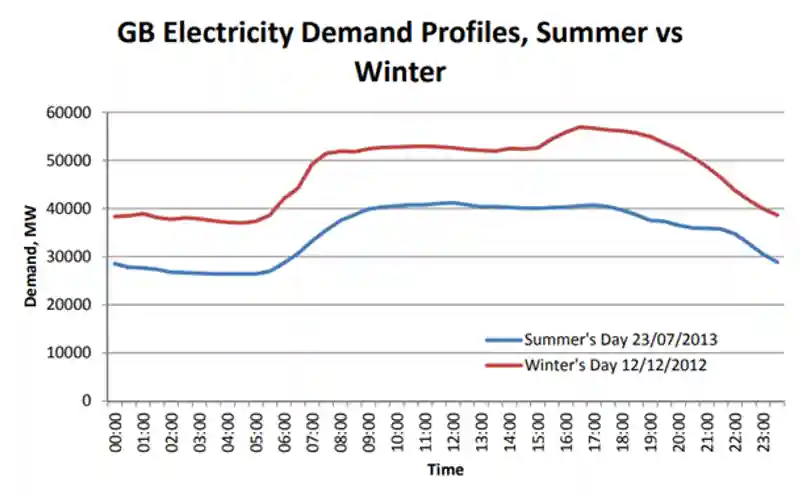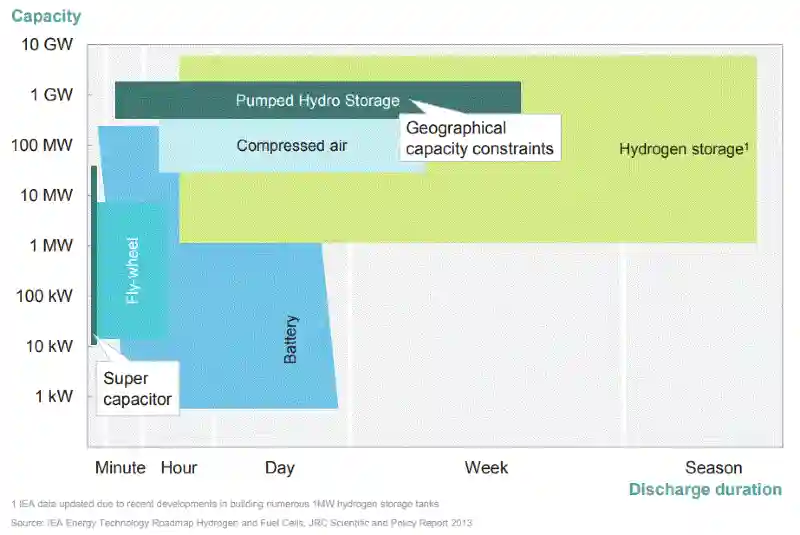Underground Green Hydrogen Storage
Green hydrogen has been lauded as the fuel of the future, as it’s clean throughout its supply chain and is vastly superior to other alternatives in industries like aviation and steel-making.
But has it ever crossed your mind that the mass-storing of green hydrogen could be used as a low-carbon, nation-scale mega-battery?
It would boost the potential of renewables while providing the UK with unprecedented clean energy security.
In this article, we cover large-scale green hydrogen storage and explain in detail its potential to transform the UK’s energy industry.
Contents
- What is large-scale green hydrogen storage?
- Why is green hydrogen storage so disruptive?
- It boosts renewable energy
- It’s a clean fuel
- It provides energy security
- It solves the seasonal energy dilemma
- The tech already exists
- It’s scalable
- What are the issues behind green hydrogen storage?
- FAQs
What is large-scale green hydrogen storage?
Like natural gas storage, large amounts of hydrogen (millions of cubic meters) can be compressed, injected and stored underground within deep rock formations.
Deep-seated salt caverns are typically the preference for hydrogen storage, with hydrogen storage already in operation in the UK at Teeside.
Hydrogen can remain sealed underground for days or centuries, and like natural gas, it can be pumped back out and re-distributed to meet demand when needed.
The current UK hydrogen economy is almost entirely dominated by blue hydrogen (produced from fossil fuels), so a key difference here is the mass production and storage of green hydrogen produced from surplus renewable energy instead.
For example, the UK’s surplus wind and solar electricity produced during off-peak hours can be converted into hydrogen via electrolysis and stored underground for winter, a supply crunch, or any other emergency.
In its hydrogen strategy, BEIS has said it is aiming for 5GW of green hydrogen production by 2030.
Why is green hydrogen storage so disruptive?
Below are six reasons why the long-term, large-scale storage of green hydrogen is so appealing:
It boosts renewable energy
The issue with some of the popular renewable alternatives is that they cannot act as base-load for the national grid because they are inherently unreliable.
Apart from the reliable output of biomass power stations like Drax, UK wind and solar depend on weather conditions and so may end up producing surplus electricity at low-peak times/seasons (e.g. a windy night on a rainy summer’s day).
So instead of going to waste, this excess electricity can be stored as clean hydrogen fuel for later use in industrial applications like clean steel-making, as vehicle and aviation fuel, heating or even renewable business energy production for the grid.
It’s a clean fuel
Currently, natural gas (of which about 2% leaks!) storage is the principal energy storage solution in the UK. However, being a fossil fuel, it emits CO2 when used, and emissions need to be reduced to achieve net zero by 2050.
In contrast, stored green hydrogen fuel is not only produced from low-carbon sources, but it produces no carbon emissions when used in a fuel cell.
It provides energy security
The current energy crisis is a prime example of why having copious energy storage is essential for the energy security of any nation.
The current issue is that the supply of natural gas has massively decreased, and the UK is heavily reliant on it to heat over 80% of UK properties and power over 40% of the national grid.
If the UK had the capability of storing very large amounts of energy (in the TWh range), the energy supply would be ample enough to buffer any supply crunches caused by unexpected events.
Examples include the war in Ukraine, the ‘windless’ year, and the 2017 government decision to remove a large part of natural gas storage capabilities, all of which are contributing to the current supply crunch.
These events are colloquially known as ‘black swans’, and with climate change and changing world order, these events are becoming increasingly common.
As the global economy, infrastructure, and military gradually migrate to hydrogen fuel, long-term storage will be increasingly essential for green energy security.
It solves the seasonal energy dilemma
The total amount of energy used in the UK in winter is approximately 30% higher than that used in summer, mainly because of the increased heating requirements. The large seasonal demand for electricity has the effect of increasing business electricity rates at peak times.
This is clearly shown in the graph below that compares electricity demand on a typical winter day (red) vs a summer day (blue).
 (Source: DECC)
(Source: DECC)
At present, electricity distribution network operators adjust electricity generation to meet demand throughout the year by burning more fossil fuels in the winter, and less in the summer.
But since the UK is legally bound to become net-zero by 2050, this balancing act must be achieved using reliable low-carbon energy sources that can be turned ON and OFF at a whim.
Some have suggested that biomass power stations like Drax could achieve this by having readily available wood pellet stocks. Unfortunately, its output is too small to single-handedly meet winter demand.
This chart shows why green hydrogen storage is the most appropriate solution for seasonal surges due to its immense scalability in terms of near-infinite storage time and capacity.
Other alternative low-carbon energy storage solutions like hydro pumping and compressed air simply cannot hold energy for long enough or at the required scale.
The tech already exists
Long-term hydrogen storage in deep salt caverns is a long-proven method, having been successfully deployed at three sites in the US and in the Teesside region since the 1970s. This means that, in contrast to more experimental energy storage methods, it may be more readily deployed in many of the UK’s salt domes that underlie the country.
Additionally, R&D exploring the adaptation of existing natural gas infrastructure (i.e. pipelines, pumps, compressors, etc) into hydrogen is optimistic.
This is a big plus for underground storage since there are currently seven salt caverns and depleted oil & gas fields that are being used to store natural gas that could be repurposed for green hydrogen storage, adding up to 1.5 billion cubic meters of capacity.
As a bonus, the existing small-scale, short-term overground storage of hydrogen in tanks or storage vessels can be leveraged to meet the short-term demand.
It’s scalable
The chart below clearly shows that hydrogen fuel is substantially more scalable, both in terms of the total energy stored and its time scale, compared to other low-carbon solutions.

According to this study, the UK has theoretical storage of 3,000TWh in underground salt domes across Cheshire, East Yorkshire and the Wessex Basin, which is equivalent to 3 years of the UK’s current energy consumption.
And according to this one, the cost of storing hydrogen in salt caverns is expected to decrease to almost £120 per MWh by 2030, which is significantly lower than existing alternatives like pumped hydro storage (£350 per MWh by 2030)
What are the issues behind green hydrogen storage?
However, there are many challenges to this massive storage solution:
- Converting underground natural gas sites into hydrogen storage sites requires a significant investment.
- Green hydrogen production from excess renewables must significantly increase to make use of the massive storage capacity. Currently, >90% of the UK’s hydrogen is produced from fossil fuels.
- Depleted oil & gas storage sites that could be used to store hydrogen offshore are also potential Carbon Capture targets.
- There are still unknown risks of adapting the existing natural gas distribution infrastructure into hydrogen.
- Hydrogen stored as a compressed gas (i.e. how it’s currently stored underground) is three times less energy-dense than compressed natural gas, which means it requires significantly more storage space as it stands.
- In terms of energy security, hydrogen storage must be accompanied by equally disruptive developments in the hydrogen economy (i.e. fuel-cell aviation and vehicles, green steal, hydrogen-powered military, etc).
- The UK still relies heavily on business gas suppliers to deliver gas across the country to power gas boilers at commercial properties.
FAQs
What is hydrogen storage?
Hydrogen storage refers to any method of containing hydrogen for a determined period of time. This could be in the order of:
- Hours in a hydrogen fuel-cell vehicle,
- days in short-term storage tanks awaiting industrial usage or
- months/years/decades in the case of underground storage.
How is hydrogen stored?
Hydrogen can be stored as a compressed gas, as a liquid at very low temperatures, or even as part of a solid mineral structure. Each storage state has its energy densities, costs and challenges.
Hydrogen can be stored in deep geological formations underground or in specialized containers above ground.
What is Green hydrogen?
Our explainer on Green Hydrogen covers this, but in summary, it is the hydrogen fuel produced using low-carbon sources of energy such as wind and solar.
How much hydrogen is lost in storage?
This depends entirely on the method of production, distribution and storage. This study suggests that given that hydrogen tech is more recent, it is likely to leak significantly less than the 2-3% average leakage loss estimate for natural gas.
How is hydrogen compressed for storage?
Hydrogen produced from electrolysis or pyrolysis comes out at a relatively low pressure of 300psi (20 bar). Compressors then force this hydrogen into tighter spaces for transport, distribution and storage.
For long-term underground hydrogen storage, the pressure depends on the depth of the enclosure, which can potentially reach up to 3000 psi (200 bar).

